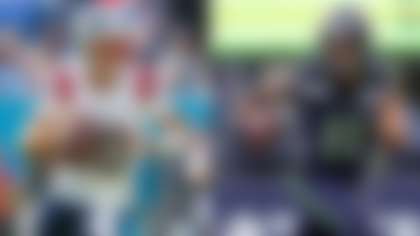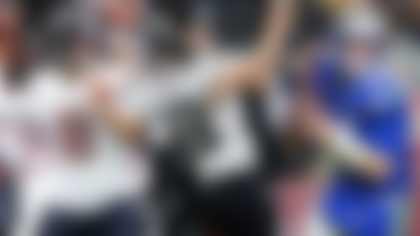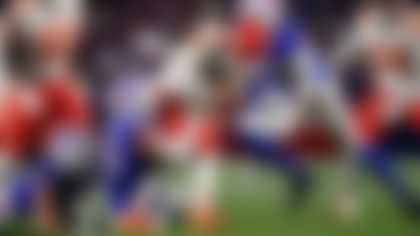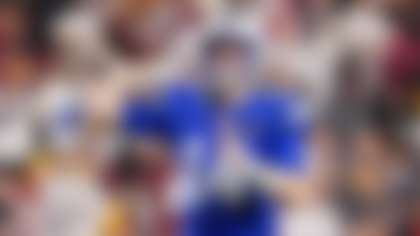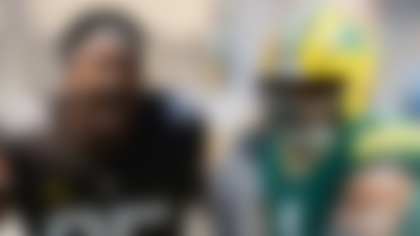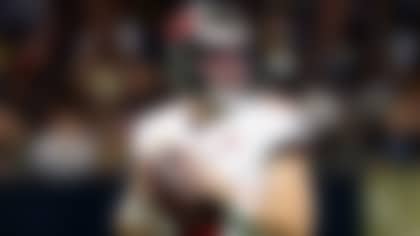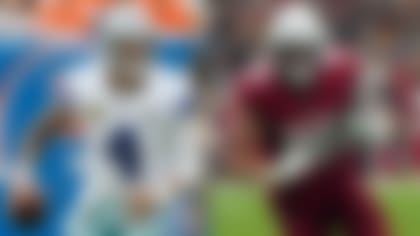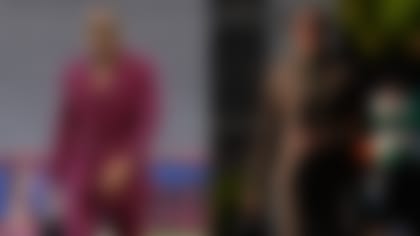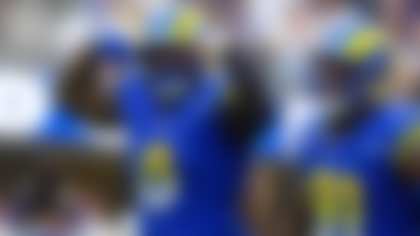The Chicago Bears were expected to vie for the NFC title with a vastly improved offense complementing a suffocating defense that had traditionally ranked among the NFL's best. While the offense has lived up to the billing in coach Marc Trestman's first season, the defense has been an epic disaster in all aspects.
The Bears rank 28th in total defense and scoring defense while fielding the NFL's worst unit against the run by a comfortable margin. After allowing an average of 102 rushing yards over the first six games, the Bears have surrendered a staggering 205.1 yards per contest over the past six. This represents a significant drop-off from the defensive standard established in Chicago through the years.
With Chicago hosting the Dallas Cowboys in what is essentially a must-win game this coming Monday, I decided to examine the All-22 Coaches Film for some clarity on this spectacular collapse. Here are three glaring problems:
1) The Bears can't run Lovie Smith's defense without Lovie Smith.
When Phil Emery fired head coach Lovie Smith at the end of last season, the general manager removed the architect of what had been one of the finest defenses in the NFL over the past decade. Over the course of Smith's nine-year tenure in Chicago, the defense ranked first in the league in takeaways, three-and-out drives forced and third-down percentage, as well as fourth in scoring defense. Most impressively, the Bears scored 34 defensive touchdowns and dominated opponents with a Tampa-2 scheme that utilized simple concepts to help defenders play at warp speed.
From a philosophical standpoint, Smith used a variety of eight-man fronts (Cover 1 and Cover 3) on early downs to stop the run and create long-yardage situations on third down. On passing downs, Smith frequently rushed four defensive linemen and dropped seven defenders into coverage, forcing quarterbacks to "dink and dunk" the ball down the field. With few quarterbacks displaying the patience to consistently drive the ball the length of the field on short passes, the Bears would routinely pick off passes on tips and overthrows in the back end.
Under defensive coordinator Mel Tucker, the Bears have struggled mightily in all aspects, despite maintaining Smith's scheme and retaining several of the former head coach's defensive assistants. Their struggles can be partially attributed to a host of injuries (more on that later) and defections, but I believe the loss of Smith's leadership is a key factor. As the architect of the scheme, Smith inherently knew all of the particulars. This allowed him to easily make tweaks and adjustments based on how offenses attacked his defense. Moreover, he could teach the finer points of the scheme to everyone, enabling all 11 defenders to remain on the same page at all times.
While Tucker has absorbed the playbook and retained the terminology associated with Smith's Tampa 2 scheme, he certainly doesn't possess the wealth of knowledge needed to fine-tune the system. Therefore, I would expect the Bears' defensive woes to continue until Tucker is able to implement his preferred scheme in Chicago.
2) Injuries have created a hole in the middle.
A rash of injuries has wreaked havoc on the core of this defense. In the wake of Brian Urlacher's retirement, the Bears have had no luck at linebacker: D.J. Williams suffered a season-ending torn pectoral muscle in Week 6, while Lance Briggs has been sidelined since Week 7 with a shoulder injury. Additionally, the unit lost defensive tackles Henry Melton and Nate Collins for the season to torn ACLs, while Stephen Paea has missed time with various injuries. Consequently, the Bears have been forced to rely on two rookie linebackers (Jon Bostic and Khaseem Greene) while rotating eight defensive tackles through the lineup.
Now, I know for a fact that most NFL coaches operate according to the "next man up" philosophy, but adding so many new pieces to the defensive puzzle has thwarted the continuity of the Bears' unit. Bostic and Greene have struggled adjusting to the speed and tempo of the pro game, playing with a hesitancy that has opened up gaps at the heart of the defense. Additionally, these two newbies fail to line up correctly at times, causing late reactions to edge runs. These things are to be expected of first-year players, but they really harm Chicago's depleted defense.
Looking at the Bears' defensive line, I see a number of guys playing out of position. For instance, Corey Wootton is normally a defensive end, but injuries have forced him to play as a three-technique this season. Although he has been used as an interior rusher in sub-packages in the past, the move to full-time defensive tackle requires him to regularly handle different responsibilities. He must take on more double teams at the point of attack and deal with stouter players on the inside (offensive guards are shorter but stronger than offensive tackles). While Wootton gives outstanding effort at the point of attack, he simply lacks the technical skills to win consistently on the inside.
Now, Shea McClellin is not an interior defender, but I have to include him in the discussion as one of the out-of-position players hindering this defense. The second-year pro was thrust into the lineup at defensive end when Wootton slid to defensive tackle, and the move has been disastrous for the Bears' defensive line. McClellin simply lacks the strength to set the edge against offensive tackles, and his inability to correctly diagnose plays has led to big gains for opponents on the perimeter, as evidenced in the video clip to the right.
Although Emery has maintained that McClellin is a nice fit at defensive end, I believe he is ideally suited to play as a 4-3 Sam linebacker or a 3-4 outside linebacker. He is a terrific athlete with the speed and quickness to chase from sideline to sideline, but he lacks the bulk (6-foot-3, 260 pounds) to hold his ground as an edge player. McClellin is a "try hard" guy with a high motor, but he is miscast in his current role.
Oh, and did I mention that All-Pro cornerback Charles Tillman is on injured reserve -- with a designation to return, but not until the playoffs -- with a triceps injury? Yeah, this is a snake-bitten defense.
3) Poor gap integrity and shoddy tackling is a recipe for disaster.
Coaches are responsible for putting defenders in a position to succeed, but players must execute their assignments and master the fundamentals to play winning football. On defense, it comes down to owning gaps in the run game and making tackles in space. In the Bears' one-gap defense, there are eight gaps along the line of scrimmage, with one defender assigned to take a gap in each defensive front. If each defender stays in his assigned gap, the defense slams the door on the running game and keeps positive plays to a minimum.
In the screengrab below, taken from Chicago's Week 9 win over the Green Bay Packers, the Bears are moving to an eight-man front, with safety Major Wright walking down into the box as a possible C- or D-gap player. Wright must react to the run and work with McClellin to make sure the outside gaps are secured:
Wright flies to the line of scrimmage after reading the run, but he heads to the D-gap, leaving the C-gap open for Eddie Lacy:
The rookie Packers running back ends up rumbling for a 56-yard gain.
In the next screengrab, taken from Sunday's overtime loss to Minnesota, the Bears are in a nine-man front to match up with the Vikings' full-house backfield. Bostic (No. 57) will act as the force player on a run to his side, with Greene (No. 59) and safety Craig Steltz (No. 20) assigned to scrape on the play. Notice how Greene is aligned in the B-gap. He should be positioned a little more to the right, based on the backfield set -- an important note to remember as the play progresses:
On the snap, Bostic attacks the line of scrimmage to take on the lead blocker. Steltz is flying to the ball from the back side to get into position to fill when Bostic squeezes the gap. However, Greene gets caught in trash near the line of scrimmage, which slows down his pursuit to the ball:
With Greene arriving late to the hole, Steltz becomes the gap player, but he is unable to fill the lane with a blocker in his face:
As a result, Peterson scoots to the outside and breaks free for a 23-yard pickup.
In the following screengrab, taken from Week 11's overtime win over the Baltimore Ravens, the Bears are aligned in a Cover 2 shell prior to the snap:
The defense intends to execute a nickel blitz, with the defensive line slanting to the right. Bostic (No. 57) is assigned to the play-side B gap, with James Anderson (No. 50) instructed to set the edge and fill the alley based on the reaction of defensive end Julius Peppers (No. 90):
However, both defensive tackles fail to work over the top of their blocks, creating an alley in the middle for Rice:
This results in a 47-yard gain, thanks to poor gap discipline and execution.
The Bears also haven't done a great job of gang tackling in the hole or on the perimeter. The linebackers and defensive backs are taking poor angles to the ball and failing to force runners to cut back into pursuit. When multiple tacklers arrive at the ball, the outside defender should attempt to hit the runner with his inside shoulder while the inside defender puts the runner on his outside shoulder, effectively sandwiching the ball carrier. Seems pretty straightforward, but the Bears just haven't been executing this kind of fundamental tackling in 2013.
How will the Cowboys attack the Bears' defense on Monday night?
I envision Dallas employing a few key tactics on "Monday Night Football":
» Pounding the ball from run-heavy formations: The Bears have been vulnerable against every conceivable run play, but the Rams and Vikings enjoyed particularly notable success over the past two weeks by attacking from "22" (2 RB, 2 TE, 1 WR) personnel groupings and other ground-based formations. By forcing Chicago to defend tightly aligned formations, the Cowboys can exploit the lack of size and strength along the Bears' front line while wearing the defense down with a host of body blows to the middle.
» Attacking the edges from spread sets: The Bears have struggled to stop the run in their nickel defense. Opponents have been effective running to the tight end side in two-by-two formations due to improper alignments and run fits by the Bears' young linebacker corps. Therefore, Dallas should utilize some "11" (1 RB, 1 TE, 3 WR) personnel packages to force the Bears into a nickel defense and run a series of "check with me" runs to the soft side. If the Cowboys are able to remove a linebacker from the box with the personnel grouping, their big, imposing offensive line should have little trouble whipping the Bears' overmatched D-line at the point of attack.
» Throwing the ball deep: Chicago's inability to stop the run has forced Tucker to incorporate more eight-man fronts and run blitzes. These tactics leave the Bears' cornerbacks locked up in one-on-one matchups on the outside. Although Tim Jennings has played at a Pro Bowl level the past few years, having him defend Dez Bryant without assistance is a scary proposition for the Bears. Moreover, it presents several big-play opportunities for Bryant and Terrance Williams on go-routes, skinny posts and double moves. With Tony Romo playing at a high level, play-action shots could lead to points for the Cowboys.
Follow Bucky Brooks on Twitter @BuckyBrooks.

